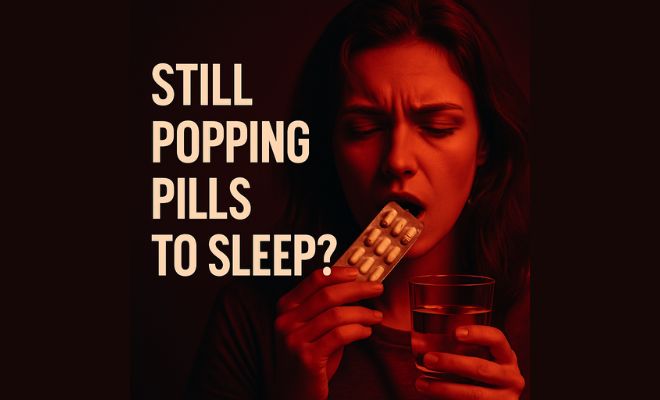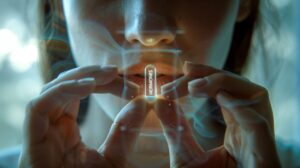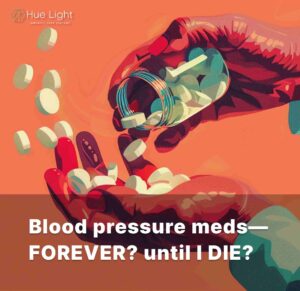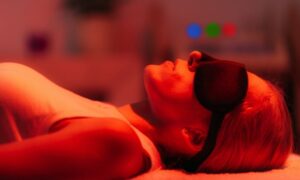We live in a sleep-deprived society. Millions of people lie awake at night, feeling exhausted but unable to switch off their minds. Many turn to sleeping pills, hoping for relief, only to find themselves stuck in a cycle of poor rest, side effects, and dependence.
But what if sleep didn’t have to be forced?
This article explores how red light therapy, and specifically Huelight’s clinical PBM system, offers a scientifically validated path to restoring natural sleep without the risks of medication.
Why Can’t We Sleep?
Stress. Overthinking. Bright screens. Caffeine. Hormonal imbalances. These modern sleep disruptors keep millions awake. The more we try to rest, the more alert we feel.
Many reach for sleeping pills because they work fast. But this quick fix has a dark side.
How Sleeping Pills Work (And Why They Can Harm)
Sleeping pills suppress the brain’s activity by enhancing GABA, a neurotransmitter that slows down the nervous system. This sedation helps you fall asleep, but not necessarily rest well.
Side effects include:
- Morning grogginess
- Memory lapses
- Dependency and tolerance
- Suppressed melatonin production
- Disrupted REM cycles, which are essential for emotional processing and memory consolidation
In short, pills force your body to sleep. They don’t help it remember how. And worse, they may prevent the very deep, restorative phases of sleep your brain and body need most.
Sleeping Pills Side Effects
Long-term use of sleeping pills has been associated with serious health risks. Studies have linked chronic use to:
- Cognitive decline
- Mood disorders such as anxiety and depression
- Increased risk of Alzheimer’s disease and other dementias

Billioti de Gage S, Moride Y, Ducruet T, et al.
Benzodiazepine use and risk of Alzheimer’s disease: case-control study.
Over time, many users find themselves stuck, unable to sleep without medication, yet never feeling truly rested even with it.
Light, Melatonin, and Skin Cancer Risk
Light is essential to the sleep-wake cycle. Morning sun suppresses melatonin, night darkness restores it. Many people try to expose themselves to more sunlight during the day, hoping to reset their circadian rhythm naturally.
But sunlight comes with a hidden danger: ultraviolet (UV) radiation. Extended UV exposure can damage skin cells, accelerate ageing, and increase the risk of skin cancer.

Source: Global Cancer Observatory (GCO), World Health Organization – Skin Cancer Incidence, 2022
According to global cancer statistics, the United States has one of the highest skin cancer incidence rates among developed countries. Seeking sunlight to fix your sleep rhythm may unintentionally raise long-term health risks, including melanoma.
What we need is a safer, controlled, and scientifically validated light source, without the UV hazards.
Red Light Therapy: Natural Sleep Without UV Risk and Sleeping Pills
Red light in the (630–700) nm range boosts melatonin production without affecting skin or hormones. Studies show that red light exposure before bed can:
- Shorten sleep latency
- Improve sleep depth
- Reduce nighttime anxiety
Unlike blue light, which suppresses melatonin, red light works with your body, not against it.
These benefits aren’t just theoretical. A 2022 systematic review and meta-analysis published in Frontiers in Neuroscience (PMID: 36588464) analysed multiple randomised controlled trials investigating red and near-infrared photobiomodulation therapy (PBMT) for insomnia. PBMT uses low-level red and near-infrared light to stimulate biological processes at the cellular level, particularly in the mitochondria, the energy-producing parts of our cells.
The study found that PBMT significantly improved total sleep time, reduced the time it took to fall asleep (sleep latency), and increased sleep efficiency in adults with insomnia. One suggested mechanism is that red light helps stabilise the autonomic nervous system, promoting parasympathetic activity, which is associated with calmness and rest. Another is that red light may regulate the release of melatonin by reducing oxidative stress in areas of the brain involved in circadian rhythm, such as the hypothalamus.
Interestingly, the study also pointed to possible activation of the glymphatic system, a waste-clearing network in the brain that is most active during deep sleep. By enhancing circulation and reducing inflammation, red and near-infrared light may support the brain’s natural detoxification process overnight, potentially improving cognitive clarity and reducing risk factors associated with neurodegenerative diseases.
Related read: Learn more about how PBM therapy can rewire your cells to fight diseases
In plain terms, red light helps the body calm down, prepare for rest, enter deeper sleep, and clean itself during the night, all without medications or side effects. This makes PBMT a promising, drug-free option for those suffering from poor sleep quality.
Huelight PBM: A Clinical Approach to Sleep Restoration
Huelight’s PBM (Photobiomodulation) system represents a clinically grounded approach to sleep support. Unlike many consumer red light products that focus only on relaxation or beauty, Huelight is designed with full medical application in mind.
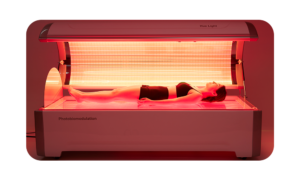
What sets Huelight apart?
- Medical-Grade Intensity: With over 40,000 high-density LED chips in its whole-body system, Huelight delivers consistent light penetration for systemic effects, not just localised warming.
- Precise Wavelength Targeting: Huelight’s PBM chamber uses 660nm red, 850nm near-infrared, and 940nm infrared light, selected to penetrate tissue at therapeutic depths and support cellular recovery.
- Advanced Frequency Control: Integrated Nogier frequency protocols help balance the autonomic nervous system—particularly beneficial for stress-related sleep disruption.
- Full-Body Coverage: Most PBM panels are limited to the face or a small body part. Huelight sets a new standard by enabling full-body exposure through its signature PBM Chamber and PBM Wing Panel system, delivering a comprehensive and rejuvenating therapeutic effect.
- Global Clinical Use: Approved in multiple countries and featured in PBM medical congresses, Huelight is trusted in professional health and recovery centres worldwide.
This system goes beyond relaxation, offering a serious, clinically validated approach to restoring restful sleep at the cellular level.
This system goes beyond relaxation, offering:
- Nervous system stabilisation (via Nogier frequencies)
- Mitochondrial and cellular recovery
- Full-body photobiological activation
How to Use It
- Use 20–30 minutes before bed
- Dim all other lights
- Avoid screens afterwards
- Stick to a consistent bedtime routine
Final Thoughts
So, does red light help you sleep without pills? Absolutely. Not by forcing your brain into sedation, but by restoring your body’s natural ability to rest, recover, and heal.
Sleeping pills might offer a shortcut, but often at the cost of cognitive health, emotional balance, and long-term well-being. In contrast, red light therapy offers a restorative, non-invasive approach grounded in biology and clinical research.
With Huelight PBM, you’re not just turning off the lights. You’re giving your cells the signal to reset. You’re syncing your internal clock. You’re investing in real, sustainable sleep.
“Ready to sleep more deeply naturally?”
Try Huelight PBM and let your body remember how to rest.
